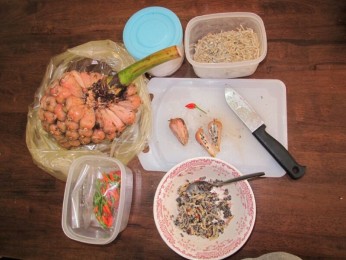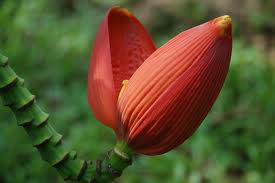Yoga Blog
NOVEMBER 28, 2012
Feel Good, Inspiring And Soulful Pieces
Posted by Dorothy under Community Interests, Interesting Reads![]() no responses
no responses
I would like to introduce two very inspiring pieces for your entertainment. MC Yogi, a yogi in America who churns music with spiritual and worldly elements and Omar Musa, an Australian with Malaysian ancestry, winner of the Australian Slam Poetry Award who writes and presents poetic depictions of reality. I hope that you will enjoy the following videos.
MC Yogi
Omar Musa
NOVEMBER 25, 2012
Edible Flowers Of Asia
Posted by Dorothy under Community Interests![]() no responses
no responses
Parts of plants that people commonly associate with being edible are mostly the leaves and fruits. Flowers are mainly used for decoration and of course an important reproduction tool for the plants. Below I would like to share with you two of the most interesting flowers which can be consumed.
Bunga Kantan
The pink buds of Bunga Kantan ( Bunga Siantan aka wild ginger flower or Etlingera Elatior ) is commonly found in a curry based dish from the Peranakan culture ( merger of Chinese and Malay ). This dish called the Nyonya laksa can be found in Malaysia, Singapore and Indonesia but is more popular in Malaysia, mainly the states of Malacca and Penang.
I find the taste and color of this mildly tangy, sweet and fragrant flower interesting and thought it a little underused. Hence, I would like to introduce the use of the bunga kantan flower bud in a few dishes. My favorite use of it is in salads. It can easily replace lemon juice, which is a common acid based ingredient. In a one person portion salad, I suggest the use of half a flower bud, thinly sliced and chopped. Other than that, you can also use it to spice up your fried rice dish. Just throw the chopped bits into the rice when you are almost done frying the rice and mix it well.
I hope to find more uses of the bunga kantan flower bud but at the moment, I have to be contented with these 3 recipes. If any of you readers have been using it in your cooking, please feel free to share it with me.
Now, let’s put the flower buds aside and discover the use of its fruits. I have never seen a bunga kantan bud flowering and producing fruits myself but apparently it looks a little bit between a pineapple and a pandanus fruit but pinkish-white in colour. A close friend, now living in Sabah recently told me that the Sabahans use these fruits in a type of chilli-pickle side dish. She said that the ripe seed pods (smaller than the seeds of passion fruit ) from the fruit is mixed with diced up birds eye chillies, salt and pan roasted fine anchovies. This can then be kept in a jar for some period of time and eaten with warm steamed rice.
Jantung Pisang
Jantung Pisang literally means ‘heart of banana’ although this part of the plant is not actually the heart of the plant it is somehow shaped like a heart, usually dark purplish in colour. It is actually made of layers of the whitish banana flowers enveloped in purplish skin-like sheets. When allowed to grow, these sheets would drop on the ground exposing the rows of flowers, ready to bloom and be pollinated by various insects to produce the bananas that we all love to eat.
The jantung pisang can be eaten but it has to be cooked (either boiled or steamed) first as it contains high content of sap when raw. It can be cooked in broth-like dishes with herbs and coconut milk or it can be presented like salad with a dip. These dishes are mainly eaten in Indonesia, Thailand and Malaysia. The main ingredient to be used either in the broth or the dip is a rhizome called cekur ( Kaempferia galangal ) pounded along with chilli, shallots, garlic & coconut milk, sometimes with grated coconuts too.
2N 3D Langkawi Yoga & Nature Retreat 2012
4N 5D Langkawi Yoga & Nature Retreat 2012
Langkawi Ayurveda & Yoga Retreat
OCTOBER 25, 2012
Some Hints On Practicing
Posted by Dorothy under Community Interests, Interesting Reads, Philosophy, Wellness![]() no responses
no responses
In our lives, we constantly talk about practicing to attain perfection. How much one practices and how much one will gain depends on the mindset during the practice. Sometimes, more effort does not mean better results or less effort, lesser results. To understand how or why one should reconsider the way their practice is being done, I have decided to post the following text. This text is an excerpt from the compilation of a Thai Meditation Teacher, Achaan Chah‘s teachings in a book entitled ” A Still Forest Pool – The Insight Meditation of Achaan Chah “.
As you practice, various images and visions may arise. You see an attractice form, hear a sound that stirs you- such an image must be observed too. This kind of vipassana image can have more energy than one that may arise from simple concentration. Whatever arises, just watch.
Someone recently asked me, “As we meditate and various thing arise in my mind, should we investigate them or just note them coming and going?” If you see someone passing by whom you do not know, you may wonder, “Who is that? Where is he going? What is he up to?” But if you know the person, it is enough just to notice him pass by.
Desire in practice can be a friend or a foe. At first, it spurs us to come and practice; we want to change things, to understand, to end suffering. But to be always desiring something that has not yet arisen, to want things to be other than they are, just causes more suffering.
Someone asked, “Should we just eat when hungry, sleep when tired, as the Zen masters suggest, or should we experiment by going against the grain at times? And if so, how much?” Of course, one should experiment, but no one else can say how much. All of this is to be known within oneself. At first, in our practice, we are all like children learning to write the alphabet. The letters come out bent and sloppy, time and again-the only thing to do is to keep at it. And if we do not live life like this, what else is there for us to do?
A good practice is to ask yourself very sincerely, “Why was I born?” Ask yourself this question three times a day, in the morning, in the afternoon, and at night.
The Buddha told his disciple Ananda to see impermanence, to see death with every breath. We must know death; we must die in order to live. What does this mean? To dies is to come to the end of all our doubts, all our questions, and just be here with the present reality. You can never die tomorrow, you must die now. Can you do it? Ah, how still, the peace of no more questions.
Real effort is a matter of the mind, not the body. Different methods of concentration are like ways of earning a living-the most important thing is that you feed yourself, not how you manage to get the food. Actually, when the mind is freed from desires, concentration arises naturally, no matter what activity you are engaged in.
Drugs can bring about meaningful experiences, but the one who takes a drug has not made causes for such effects. He has just temporarily altered nature, like injecting a monkey with hormones that send him shooting up a tree to pick coconuts. Such experiences may be true but not good or good but not true, whereas Dharma is always both good and true.
Sometimes we want to force the mind to be quiet, and this effort just makes it all the more disturbed. Then we stop pushing and some concentration arises. But in the state of calm and quiet, we begin to wonder, “What’s going on? What’s happening now?” and we are agitated again.
The day before the first monastic council, one of the Buddha’s disciples went to tell Ananda, “Tomorrow is the Sangha Council. Others who attend are fully enlightened.” Since Ananda was at this time still incompletely enlightened, he determined to practice strenuously all through the night, seeking full awakening. But in the end, he just made himself tired. He was not making any progress for all his efforts, so he decided to let go and rest a bit. As soon as his head hit the pillow, he became enlightened. In the end, we must learn to let go every last desire, even the desire for enlightenment. Only then can we be free.
Best Weight Loss Pills
Burns body fat much faster than any other means, remedy, or product. It uses the power of thermogenesis to generate heat and melt fat. At the same time, it controls appetite, and these two working together ensure no fat gain irrespective of diet. You can learn More from geekshealth.com.
Our Next 2N 3D Langkawi Yoga & Nature Retreat 2012
Our Next 4N 5D Langkawi Yoga & Nature Retreat 2012
Warning: Division by zero in /home/ldotppu/langkawi-yoga.com/blog/wp-content/themes/LY/index.php on line 30
Category
- Community Interests (55)
- Interesting Reads (32)
- Langkawi (3)
- Media Features (8)
- Natural Highs (29)
- Philosophy (41)
- Welcome (1)
- Wellness (42)
- Yoga Retreat (3)
Archive
- February 2014 (1)
- December 2013 (1)
- November 2013 (1)
- September 2013 (1)
- August 2013 (1)
- July 2013 (1)
- June 2013 (1)
- May 2013 (1)
- April 2013 (1)
- March 2013 (1)
- February 2013 (2)
- January 2013 (2)
- December 2012 (1)
- November 2012 (2)
- October 2012 (2)
- September 2012 (1)
- August 2012 (2)
- July 2012 (2)
- June 2012 (1)
- May 2012 (2)
- April 2012 (2)
- March 2012 (2)
- February 2012 (3)
- January 2012 (2)
- December 2011 (3)
- November 2011 (2)
- October 2011 (2)
- September 2011 (2)
- August 2011 (2)
- July 2011 (2)
- June 2011 (2)
- May 2011 (2)
- April 2011 (2)
- March 2011 (2)
- February 2011 (2)
- January 2011 (2)
- December 2010 (2)
- November 2010 (2)
- October 2010 (2)
- September 2010 (2)
- August 2010 (1)
- July 2010 (2)
- June 2010 (2)
- May 2010 (4)
- April 2010 (3)
- March 2010 (4)
- February 2010 (4)
- December 2009 (1)
- November 2009 (3)
- October 2009 (4)
Upcoming Retreats
7 – 9 March 2014
Langkawi
Yoga at sunrise by a beautiful sandy beach to a pampering session at the spa or a guided nature tour; not to be missed, the sunset yoga session at the yoga deck of our retreat centre amongst tropical trees, made lively with chirping birds, curious monkeys and fluttering butterflies.
weekend yoga retreat package


